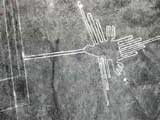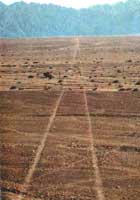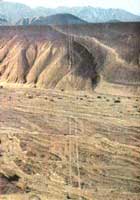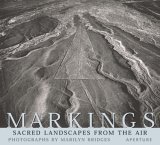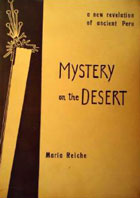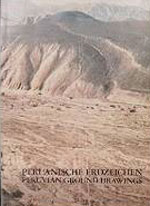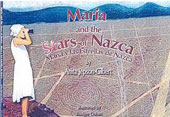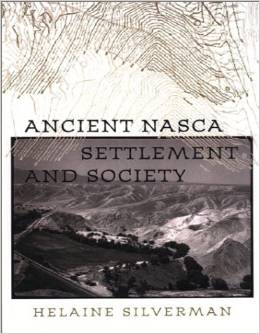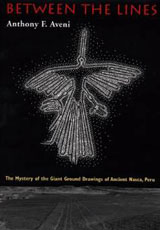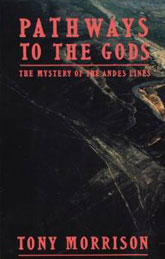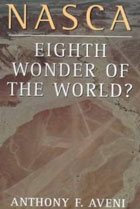|
Probably the best known examples of geoglyphs are the magnificent lines and drawings carved into the desert on the Nazca Plain in Peru – only able to be seen in their fullness from the air. The ‘Nazca Lines’ were discovered in 1939 by Toribio Mejia Xesspe, who was followed by Dr. Paul Kosok of Long Island University, who in 1946 handed over over all his information about these amazing geoglyphs on the Nazca Plain to Maria Reiche, a mathematician and graduate of Hamburg University.
Others who have made significant contributions to the understanding of the geoglyphs at Nazca, and importantly to their preservation, include Italian archaeologist Giuseppe Orefici, Johann Reinhardt and countless other researchers, photographers, journalists, archaeologists and scientists, who have worked closely with the former INC and now the ministry.
Maria Reiche spent the next fifty years living on the Nazca Plain close to the area of the drawings, painstakingly mapping each one, and trying to protect them from the encroaches of modern civilisation. She died aged 95 in Peru in June 1998, and left many feeling that the great Nazca geoglyphs had lost their champion.
She was laid to rest besides the enigmatic drawings she spent half a lifetime protecting. And, as you will see from some of the aerial photographs, car tracks, horses hoof prints, and even the Pan-American highway have all contributed to the destruction of a number of the drawings. In many respects this has been caused simply by the sheer size of the geoglyphs which can only be appreciated properly from the air. It is the sheer size of the work undertaken by the ancient Peruvians that continues to fascinate all who encounter them, and Maria Reiche explains in her book, “Mystery on the Desert”, the method of construction:
“It seems almost incredible that ground-drawings made by superifcially scratching the surface could have withstood the ravages of time and weather over such long periods. The climate is one of the driest of the globe. One could say that it rains for half an hour every two years. And although strong winds carry great quanitites of sand, not encountering any obstacles on the vast tablelands open towards the north and south, they take it further north, where at seventy miles distance one can see huge dunes on both sides of the (Pan-American) highway. Moreover, close to the ground the air is becalmed considerably. Owing to their dark color, the surface stones absorb much heat, causing a cushion of warm air to protect the surface from strong winds.
An additional factor contributing to the ground remaining undisturbed for hundreds of years is that the soil contains a certain amount of gypsum which, moistened by daily morning-dew, slightly affixes every stone to its base. This makes it possible to retrace the steps by which the ancient topographers laid out the accurate shapes of their complicated structures, having used stones as markers which have remained in the same place where they were put when the drawings were made. It was found, for example, that the huge regular curves of animal-figures were composed of segments of circles, whose centres were marked by a stone which had been, or was cut to, one hundredth of the the corresponding radius.”
Since that time many others have taken up the Nazca cause and, although some have felt that Maria Reiche’s explanations of the lines, geometric shapes and geoglyphs of animals, birds and fish on the desert are only part of the story, all agree that without her lifelong efforts to protect them, many more of the lines and drawings would most certainly have been destroyed by now.
Below are some of the latest discoveries, news items and the thoughts of archaeologists, anthropologists, astronomers and a wide variety of others who have explored these enigmatic geoglyphs in Peru.
Building on the pioneering work of Maria Reiche, The Morien Institute archive is also providing our visitors with news of new discoveries in various other parts of the world which show that geoglyphs were constructed by many ancient cultures.
“Driver ploughs into historic Nazca Lines
while trying to dodge highway toll”
January 31, 2018, IB Times, UK:
“A truck driver is facing criminal charges after ploughing into the world-famous Nazca lines in Peru
According to the Peruvian Ministry of Culture, the driver entered the archaeological zone as he was trying to pay a highway toll.
He ignored warning signs and drove into the fragile pre-Inca remains on 27 January.
The incident left ‘deep prints in an area approximately 100 metres-long’, and damaged ‘parts of three straight-lined geoglyphs’, according to the Ministry of Culture.
The man was detained by security guards and later charged. The lines have been designated a Unesco World Heritage site since 1994.
Entering the zone is strictly forbidden due to the fragility of the soil that surrounds them and the man faces between three to six years in prison if found guilty.
Peruvian authorities stipulate that visitors and pedestrians wear foam-covered footwear in the zone.”
[Read The Full Story]
[What a great pity! More damage done to the geoglyphs at Nazca – this time from a local man. It’s worth a visit to read the full story and see the aerial photos of the damage done now, and the dreadful disrespect shown to this unique UN World Heritage archaeological site by Greenpeace activists in 2014 – Ed.]
“New Giant Geoglyph of Orca Discovered in Peru Desert
Sheds Light on Enigmatic Monuments”
November 16, 2017, Newsweek, USA:
“A massive ‘drawing’ of a killer whale has been found in the legendary Nazca Lines of Peru.
It could be the oldest image ever recorded at the site.
In 2013, scientists found what they believed to be an enormous depiction of a sea creature roughly 250 miles south of Lima.
Researchers from the Commission for Archaeology of Non-European Cultures (KAAK) of the German Archaeological Institute collaborated on the project with other partners, including members from the Instituto Andino de Estudios Arqueológicos (INDEA).
After years of analysis, restoration work, and debate, they’ve confirmed it’s an orca.”
[Read The Full Story]
[WOW! Another massive geoglyph discovered at Nazca. This is well worth the read and seeing the aerial photos of the find – Ed.]
“Discovery of New Geoglyph Keeps the
Nazca Lines from Fading”
May 02, 2016, New Historian, UK:
“A new geoglyph at Pampa de Majuelos in the Nazca Desert of southern Peru highlights the archaeological site’s importance to the scientific community once again.
The new geoglyph is a 30-meter-long figure representing an animal with a long tongue; on the left side of the figure a head is depicted, while the right side might reveal the legs and body.
The figure is believed by researchers to represent an imaginary figure as opposed to an actual animal.
Declared a UNESCO World Heritage Site in 1994, the ancient Nazca Lines are a collection of geoglyphs spread across almost 190 square miles of desert, approximately 400 km south of Lima.
The Nazca Lines, experts believe, were created between 500 BCE and 500 CE by the Nazca culture.”
[Read The Full Story]
[It makes you wonder how many more geoglyphs will be discovered at Nazca – Ed.]
“Yamagata University team discovers 24 ancient
geoglyphs in Peru”
July 08, 2015, The Asahi Shimbun, Japan:
“Anthropologists have discovered 24 examples of the mysterious Nazca Lines in the arid region near Nazca of southern Peru, a Yamagata University institute researching the geoglyphs announced July 7.
The discovery was made by a team of about 10 researchers, including Masato Sakai, a professor of cultural anthropology at the university who is also the deputy director of the university’s Nazca research institute.
The team began investigating the northern slopes of the urban areas of Nazca, Peru, from autumn 2013 and discovered 17 geoglyphs depicting llamas before the end of fiscal 2013.
The newest announcement is based on the team’s findings in fiscal 2014.
They discovered five new examples near the area where they found geoglyphs the previous fiscal year and 19 more on the slopes of a nearby mountain.”
[Read The Full Story]
[Perhaps the fainter markings are simply much older evidence of a very long tradition of drawing geoglyphs at Nazca – Ed.]
“Editorial: Don’t Tread On Me”
January 14, 2015, Andean Airmail & Peruvian Times, Peru:
“Over the course of five decades, German-born Peruvian archaeologist Maria Reiche dedicated her life to studying and preserving the Nazca Lines, which she tread in flip-flops, armed with a broom.
That image of the self-appointed ‘Lady of the Lines’ is incongruous with the calamitously ill-conceived publicity stunt pulled by 20 Greenpeace activists last month.
Sneaking into the restricted zone in a predawn march, they allegedly caused ‘irreparable damage’ to the iconic hummingbird geoglyph when they laid a message that read “TIME FOR CHANGE,” directed at climate change negotiators at the COP20 UN summit, 280 miles north in capital Lima.
Seemingly to make up for years of half-hearted efforts to protect the lines from illegal miners, land squatters, truck and race car drivers and tomb raiders, Peru’s Ministry of Culture decided to throw the book at the environmentalists.
And to emphasize this newly discovered resolve, the Culture Ministry has decided to widen its focus and go after a Japanese TV crew and its own resident archaeologist, who two years ago led the TV crew to the hummingbird drawing. A photographer with Associated Press, who covered the Greenpeace actions, is also being indicted.
Greenpeace undoubtedly calculated that it would create a scandal with its action and expected some reprisal. As it should.
But at the same time the Culture Ministry should be consistent in its own actions and policies, and the Nazca Lines are an example of the reactions rather than pro-active actions taken throughout the country, today by the Culture Ministry as it was for decades by its earlier form, the National Institute of Culture, INC.
There is an increasing pressure on archaeological areas everywhere, due to urban and industrial sprawl, and Nazca is no exception.
Yet the lack of decentralization, of not granting a certain autonomy to regional and provincial Culture Ministry offices, leads to slow or no action until an event like the Lines hits the headlines and triggers an over-reaction.
But the real damage that never raises the scandal decibels to that of the Greenpeace fiasco comes from the growing number of land invasions on the plains, from informal mineral plants refining illegal gold brought in from the rainforest, and countless tracks carved out by vehicles to find short-cuts or avoid the toll highway.”
[Read The Full Story]
[We have re-printed most of this story because of the important points made relevant to the preservation of the the unique geoglyphs at Nazca – Ed.]
“Mystery Surrounds Delicate Nasca Lines
Threatened by Greenpeace Stunt”
December 12, 2014, Peruvian Times, Peru:
“Ancient line drawings in the Andean desert, one of history’s biggest mysteries, generated a firestorm of complaints against an environmental group that damaged the lines in a stunt this week.
The environmental group Greenpeace apologized on Wednesday for unfurling a sign calling for renewable energy next to a giant hummingbird design, one of the huge drawings called the Nasca lines.
The message, spelled out in yellow plastic letters, was timed to get attention during a major climate conference in Lima.
Greenpeace activists made an unauthorized intrusion into the World Heritage site to place the sign, resulting in protest from Peru.
Almost lost in the controversy were the Nasca lines themselves, which the United Nations Educational, Scientific and Cultural Organization (UNESCO) calls ‘one of the most impenetrable enigmas of archaeology’.
All together, more than a thousand straight lines, geometric shapes, and plant and animal figures dot the 174 square miles (450 square kilometers) of the Nasca Desert and foothills.
Preserved by centuries of sun with little rain, the longest stretches more than 7.5 miles (12 kilometers), and the largest figure, a pelican, is some 935 feet (285 meters) long.
The banner was located only a few meters from one of the most famous Nazca drawings, the hummingbird.
Careful removal of the dark varnished crust from the lighter-colored desert floor created the lines, called geoglyphs, made more than 1,500 years ago by ancient Andean people.
Native Americans as far north as California used a similar method for creating desert drawings, most famously the Blythe ‘Intaglios’, depicting large human figures.”
[Read The Full Story]
[Well done NatGeo writer, Dan Vergano, for pointing out that the importance of these unique lines and geoglyphs was almost lost in the scramble by Greenpeace to apologise for this stupid stunt. We recommend you read the comments at the bottom of the story, and visit the excellent NatGeo Nasca Photo Gallery – Ed.]
“Greenpeace Director in Lima to Apologize
for Nazca Lines Stunt”
December 12, 2014, Peruvian Times, Peru:
“President Ollanta Humala lashed out yesterday at Greenpeace, saying that their recent stunt at the Nazca Lines to raise awareness for clean energy showed a ‘lack of respect.’
‘We have been able to appreciate two messages, one explicit but there was another bigger implicit one’, Humala said, according to daily El Comercio. ‘The lack of respect for our cultural heritage and Peruvian laws.’
Kumi Naidoo, Greenpeace’s executive director, arrived in Lima late Thursday, to offer his apologies for the organizations Nazca Lines action, and is scheduled to meet officials at the Ministry of Culture on Friday afternoon.
He said the organization would face the consequences of its actions.
One of the Greenpeace messages at Machu Picchu
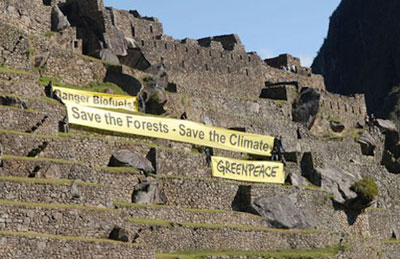
Copyright © 2014 Peruvian Times
Greenpeace activists from a number of countries sneaked into the area of the famous Nazca Lines in southern Peru, and worked through the night to set up a massive banner that read in yellow letters: ‘Time for Change! The Future is Renewable. Greenpeace.’
The banner was located only a few meters from one of the most famous Nazca drawings, the hummingbird.
The Culture Ministry said the stunt caused irreparable damage in the fragile area near the hummingbird.”
[Read The Full Story]
[The future may well be renewable Mr Naidoo, but the Nazca geoglyphs, Machu Picchu, and ALL of Peru’s cultural heritage sites are most certainly not – Ed.]
“Greenpeace apologizes for Nazca lines stunt”
December 10, 2014, The Times-Union, USA:
“Greenpeace said Wednesday that its executive director will travel to Peru to personally apologize for the environmental group’s stunt at the world-famous Nazca lines, which Peruvian authorities say harmed the archaeological marvel.
The group said it was willing to accept the consequences. A senior Peruvian official told The Associated Press on Tuesday evening that his government would seek criminal charges against Greenpeace activists who allegedly damaged the lines by leaving footprints in the adjacent desert.
‘We fully understand that this looks bad’, Greenpeace said in a statement Wednesday. ‘We came across as careless and crass.’
Monday’s action was intended to promote clean energy to delegates from 190 countries at the U.N. climate talks in nearby Lima.
But the group signaled in the second of two emails Wednesday that it recognized it had deeply offended many Peruvians.”
[Read The Full Story]
[Photo of Greenpeace activists at the hummingbird geoglyph in Nazca]
“Peru riled by Greenpeace stunt at Nazca lines”
December 09, 2014, The Times-Union, USA:
“Peru will seek criminal charges against Greenpeace activists who damaged the world-renowned Nazca lines by leaving footprints in the adjacent desert during a publicity stunt, a senior government official said Tuesday.
‘It’s a true slap in the face at everything Peruvians consider sacred’, Deputy Culture Minister Luis Jaime Castillo said of Monday’s action by the environmental group at the famed drawings etched into Peru’s coastal desert, a U.N. World Heritage site.
He said the government was seeking to prevent those responsible from leaving the country while it asks prosecutors to file charges of ‘attacking archaeological monuments’, a crime punishable by up to six years in prison.
The activists entered a ‘strictly prohibited’ area beside the famed figure of a hummingbird, the Culture Ministry said in a statement. They laid big yellow cloth letters reading: ‘Time for Change; The Future is Renewable’. The message was intended for delegates from 190 countries at the U.N. climate talks being held in nearby Lima.
Castillo said no one, not even presidents and Cabinet ministers, is allowed without authorization where the activists trod, and those who do have permission must wear special shoes.”
[Read The Full Story]
[This totally irresponsible prank should NOT go unpunished. Those who once supported Greenpeace in the past, but who withdrew support several years ago when it began promoting nuclear power as a “clean energy” way to halt global warming, won’t be surprised at these idiots’ latest prank.
Many of them fly around the world posing as “environmentalists” and claiming they are “trying to save the planet”, yet fail to even consider our planet’s interactions with its own natural environment – the solar system.
The past 10-15 years has seen increasing investment in “SpaceWeather Research”. This investment hasn’t been initiated by the so-called “climate change deniers” but by far, far more scientists than exist in the supposed “consensus of leading scientists” who promote “man-made global warming and CO2” as the sole cause.
While they are deservedly in jail for destroying the restricted areas near the irreplaceable Nazca geoglyphs, those Greenpeace activists might be wise to begin learning a bit about “Cosmoclimatology” – Ed.]
“Nazca Lines of Kazakhstan:
More Than 50 Geoglyphs Discovered”
September 23, 2014, Live Science, USA:
“More than 50 geoglyphs with various shapes and sizes, including a massive swastika, have been discovered across northern Kazakhstan in Central Asia, say archaeologists.
These sprawling structures, mostly earthen mounds, create the type of landscape art most famously seen in the Nazca region of Peru.
Discovered using Google Earth, the geoglyphs are designed in a variety of geometric shapes, including squares, rings, crosses and swastikas (the swastika is a design that was used in ancient times).
Ranging from 90 to 400 meters (295 to 1,312 feet) in diameter, some of them are longer than a modern-day aircraft carrier.
Researchers say that the geoglyphs are difficult to see on the ground, but can easily be seen from the sky.”
[Read The Full Story]
[In Photos: Google Earth Reveals Sprawling Geoglyphs in Kazakhstan]
“New Nazca Lines geoglyphs uncovered by
gales and sandstorms in Peru”
August 04, 2014, The Independent, UK:
“High winds and sandstorms in Peru have revealed previously undiscovered geoglyphs in the ancient Nazca Lines.
Eduardo Herrán Gómez de la Torre, a pilot and researcher, found the new shapes while flying over the desert last week, El Comercio reported.
He believes one of the geoglyphs depicts a snake 60 metres long and 4 metres wide, near the famous ‘hummingbird’.
A bird, camelids (possibly llamas) and a zig zag line are among the lines found etched into the ground on hills in the El Ingenio Valley and Pampas de Jumana.
Archaeologists are already trying to confirm whether they match the Paracas culture in the Ica region of Peru, which flourished from 800BC to 100BC and influenced complex textiles and ceramics at Nazca as well as the lines.”
[Read The Full Story]
[Watch the Video: Wingsuit skydivers glide over the Nazca lines in Peru]
“Mysterious rock lines in Peru
likely marked way to ancient fairs”
May 06, 2014, Fox News, USA:
“New rock lines discovered in Peru predate the famous Nazca Lines by centuries and likely once marked the site of ancient fairs, researchers say.
The lines were created by people of the Paracas, a civilization that arose around 800 B.C. in what is now Peru.
The Paracas culture predated the Nazca culture, which came onto the scene around 100 B.C.
The Nazca people are famous for their fantastic geoglyphs, or rock lines, built in the shapes of monkeys, birds and other animals.
The new lines date to around 300 B.C., making them at least 300 years older than the oldest Nazca lines, said Charles Stanish, the director of the Cotsen Institute of Archaeology at the University of California, Los Angeles, who reported the new find May 5 in the journal Proceedings of the National Academy of Sciences.
‘They used the lines in a different way than the Nazca,” Stanish told Live Science. “They basically created these areas of highly ritualized processions and activities that were not settled permanently.'”
[Read The Full Story]
“Mysterious Animal-Shaped Structures In Peru
Are Oldest Known”
February 16, 2011, Andina, Peru:
“Manmade mounds shaped like orcas, condors and even a duck may be the oldest evidence of animal mounds outside of North America, according to former University of Missouri anthropologist.
Writing in the magazine Antiquity, Robert Benfer, a professor emeritus, describes a series of mounds, some more than 1,300 feet (400 meters) across, in coastal valleys in Peru.
Archaeological evidence at the sites pegs some at more than 4,000 years old.
“It’s going to shake everybody’s views,” Benfer told LiveScience. “The previous oldest animal figures were at Nazca and they’re 2,000 years old.”
The Nazca Lines are simple stone outlines of animals decorating the Nazca Desert in Peru. Like the newly discovered mounds, they may have had ritual significance.
In addition, the shapes likely coincided with the constellations these ancient people saw in the Milky Way. Its orientation and slant angle are aligned with the altitude of the sun at midsummer, researchers said.”
[Read More] –
[See Images of the Animal Mounds]
“Nasca geoglyphs may be found along Rio Grande basin”
February 16, 2011, Andina, Peru:
“Nasca ancient geoglyphs are found in the pampas, but they may be found along Rio Grande basin, too, said archaeologist Alberto Urbano, officer in charge at Nasca Regional Directorate of Culture.
Urbano alleges that this hypothesis has emerged after the recent finds of two high relief figures and 138 line centers discovered by a team of researchers at Japan?s Yamagata University.
Japanese researchers were assisted by Peruvian Jorge Olano and , all together carried out a research study in this southwest sector of the pampas in Cacahuasi area. Such a project was completed in late January.”
[Full Story]
“Scientists claim new geoglyph find in Nazca, Peru”
January 20, 2011, Living in Peru, Peru:
“Two scientists from Yamagata University in Japan reported finding two new geoglyphs in southern Peru?s Nazca province, Andina reported.
Are these new Nasca geoglyphs?
Japanese archeologists say ye
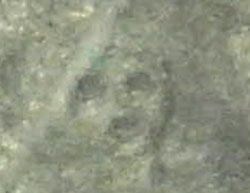
Yamagata University
The new geoglyphs depict a human head and an animal figure that the researchers have yet to identify, state news agency Andina reported. According to the archaeology faculty chief at Yamagata, Yoichi Watanabe, the drawing of the human head is 4.2 meters long and 3.1 m wide.
The geoglyphs have most probably not been identified in aerial surveys before because of their small size, Watanabe said.”
[Full Story]
“Nasca Lines may be giant map of underground water sources”
August 27, 2010, Andina, Peru:
“American researcher David Johnson has advanced a theory that Nasca Lines may be related to water. He thinks that the geoglyphs may be a giant map of the underground water sources traced on the land.
The Nasca Lines are located in the Peruvian desert, about 200 miles south of Lima. The assortment of perfectly-straight lines lies in an area measuring 37 miles long and 1-mile wide.
The Nasca plain is one of the driest places on Earth, getting less than one inch of rain a year. So, when Johnson started his research in 1995, he became aware of the scarcity of water in the region and the effect that this had on agricultural production and the quality of life.
While looking for sources of water, he noticed that ancient aqueducts, called puquios, seemed to be connected with some of the lines. “
[Full Story]
“Nasca Lines aerial views on National Geographic magazine”
March 18, 2010, Andina, Peru:
“Peru’s Nasca Lines were captured by National Geographic photographer Robert Clark.
An aerial view of a Nazca geoglyph
taken by Robert Clark for National Geographic
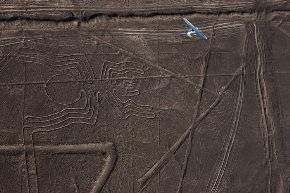
Robert Clark for National Geographic
Pictures are remarkable for their beauty and originality, especially aerial views that enhance the ongoing debate rather than revealing the origin of geoglyphs.
The March edition of the prestigious National Geographic magazine, covering wildlife and environment conservation issues, contains a stunning photo gallery of Nasca Lines and its surroundings.
Since the lines became widely known in the late 1920s, when commercial air travel was introduced between Lima and the southern Peruvian city of Arequipa, the lines have puzzled all the world.”
[Full Story]
“The Nasca Lines: An Incredible Fly-Over”
December 01, 2009, Living in Peru, Peru:
“One of the many well known wonders of Peru are the famous Nasca lines located on the Nasca plains in the southern part of Peru.
The Nasca were one of many ancient cultures that reached great heights in this amazing country.
The Nasca flourished from 200 BC to 700 AD and left behind not only a remarkable city with at least 17 temples, which are just being excavated, as well as a very advanced aqueduct system, but they also left these remarkable designs in the desert.
An aerial view of the spider geoglyph taken by Rodney L. Dodig
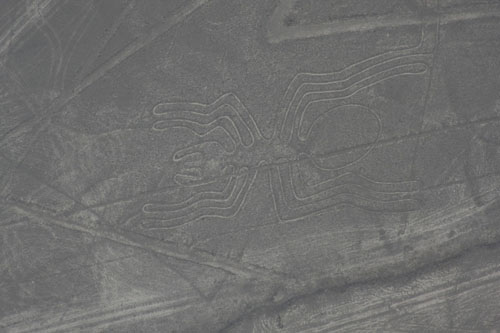
Rodney L. Dodig for Living in Peru
Most of them cannot be seen and appreciated unless you are flying over them in a plane, although a few can be discerned from the observation towers located in the area.
On a recent excursion with friends visiting from the United States I had the opportunity to view these stunning works.
Our fly over included the Trapezoids, the Astronaut, The Monkey, the Dog, the Condor, the Spider, the Frigate Bird, the Spider, the Humming Bird, Alcatraz, the Parrot, the Tree, the Hands and the Baby Condor as well as seeing some spectacular desert scenery.
Researchers have demonstrated that the construction of even the most complicated geoglyph could have been accomplished by 4 or 5 people in less than a week.”
[Full Story]
“Nazcas’ destruction of forests caused downfall”
November 01, 2009, The Sunday Telegraph, UK:
“An ancient civilisation brought about its own demise by destroying forests which kept its delicate ecosystem in balance, according to researchers who claim the discovery has important implications for the modern world.
Archaeologists examining the remains of the Nasca, who once flourished in the valleys of south coastal Peru, discovered a sequence of human-induced events which led to their ‘catastrophic’ collapse around 500 AD.
The Nasca civilisation, noted for creating vast patterns in the desert that can only be seen from the air, disappeared partly because it damaged the fragile ecosystem that held it in place, a study found.
Author Oliver Whaley, of the Royal Botanic Gardens, Kew, said: ‘The mistakes of prehistory offer us important lessons for our management of fragile, arid areas in the present.’
In the study published in the journal Latin American Antiquity, the researchers found that the Nasca cleared areas of forest to make way for their own agriculture over the course of many generations.”
[Full Story]
“Nazca Lines to be protected from heavy rains”
April 13, 2009, AFP, France:
“The National Institute of Culture (INC) is currently preparing a preservation project to prevent damaged caused by weather on the enigmatic Nazca Lines, (Ica region) reported Mario Olaechea, resident archaeologist of this organization in Nasca.
‘It’s a project that will serve the whole area in general, to avoid events such like the one last January, when rainwater accumulated and drained, covering with layers of clay the geoglyph called La Mano (The Hand)’, he said.
‘Only 1% of the geoglyph was covered by the clay layer, and will be withdrawn very soon’, he said.”
[Full Story]
“Nazca Lines to be protected from heavy rains”
April 13, 2009, AFP, France:
“The National Institute of Culture (INC) is currently preparing a preservation project to prevent damaged caused by weather on the enigmatic Nazca Lines, (Ica region) reported Mario Olaechea, resident archaeologist of this organization in Nasca.
The Nasca lines are a collection of lines, giant trapezoids, and figures of humans, plants and animals in a desert 400 kilometres south of Lima, Peru.
They were created between 400 BC and AD 650 by the removal of reddish oxidised stones from the desert pavement to reveal the lighter sand beneath.
‘It’s a project that will serve the whole area in general, to avoid events such like the one last January, when rainwater accumulated and drained, covering with layers of clay the geoglyph called La Mano (The Hand)’, he said.
‘Only 1% of the geoglyph was covered by the clay layer, and will be withdrawn very soon’, he said.”
[Full Story]
More information about the Nazca geoglyphs at:
Maria Reiche
“Rituals of the Nasca Lines: New excavations reveal the purpose and origin of the famed geoglyphs”
May 2009 Edition, Archaeology Magazine, USA:
“It was a little after eight in the morning and the sun was still low on the horizon. Jammed in the back of a six-seat Cessna Stationair flying low over Peru’s Atacama Desert, I felt a rush of air. Glancing up, I saw the pilot holding the plane’s window open with his left hand while steering us into a tight, banking turn with his right.
Soon I spotted a wide, straight line that extended for hundreds of yards then turned 90 degrees to the left. Next to it lay the faint outlines of a whale traced in stone. It was one of the Nasca lines.
This excavation of a site near the lines at Pernil Alto in the Palpa Valley
turned up evidence of a pre-Nasca settlement
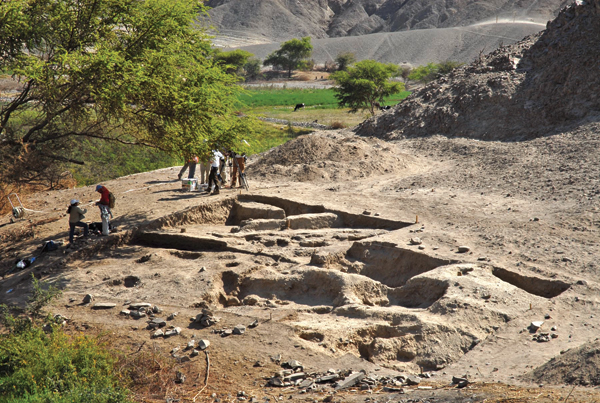
Andrew Curry / Archaeology Magazine
Created by Peru’s Nasca culture between 400 B.C. and A.D. 600, the lines have puzzled researchers since they were first noticed by pilots in the 1930s.
How could a prehistoric culture have made designs that are essentially invisible from ground level–and why?
Oyster (Spondylus) shells were crafted into ornaments
and left as sacrifices in Nasca water rituals

Andrew Curry / Archaeology Magazine
After a decade-long effort, an international team of archaeologists, geologists, chemists, and even computer scientists from Germany, Switzerland, and Austria say they’ve cracked the secrets of the lines, revealing how they were constructed and why.
If they’re right, it could lay to rest a 60-year-old debate over whether the Nasca used the lines as astronomical observatories or water maps, or for some other purpose entirely.”
[Full Story]
“Peruvians walked their prayers into the earth”
January 26, 2009, New Scientist, UK:
“The ancient, intricate geometric patterns stamped on the surface of a desert in Peru have long been thought of as messages to the gods, or as markers that tracked celestial objects.
Now new details about these geoglyphs suggest they may have been made for ‘prayer walking’.
Nazca culture’s geoglyph known as “The hand”
flooded by the Nazca river
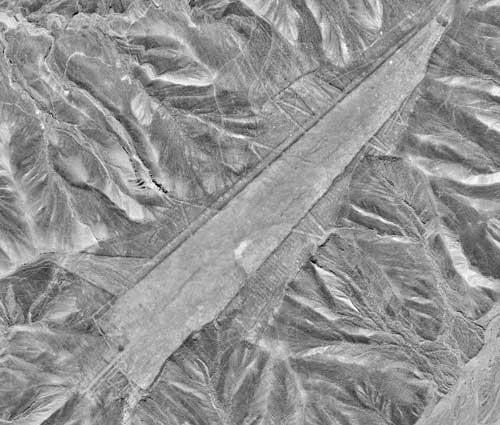
Karsten Lambers / New Scientist
Institute of Geodesy and Photogrammetry, ETH Zürich, Switzerland
The Nasca lines are a collection of lines, giant trapezoids, and figures of humans, plants and animals in a desert 400 kilometres south of Lima, Peru.
They were created between 400 BC and AD 650 by the removal of reddish oxidised stones from the desert pavement to reveal the lighter sand beneath.
Tomasz Gorka of Munich University in Germany analysed five geoglyph complexes near the city of Palpa, focusing on the large trapezoidal structures which are etched on the plains there.
He measured anomalies in the Earth’s magnetic field caused by changes in soil density at various depths.”
[Full Story]
“Heavy rains alter Peru’s famed Nazca Lines”
January 21, 2009, AFP, France:
“Heavy rains in recent days in Peru have affected the famed Nazca Lines, the two-millennia-old giant outlines that are one of the country’s top tourist attractions, officials said Tuesday.
Nazca culture’s geoglyph known as “The hand”
flooded by the Nazca river
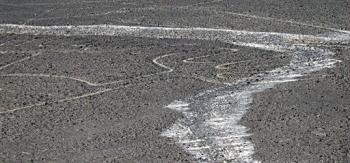
AFP, France
The precipitation left a layer of white clay on parts of two of the geoglyphs, ‘giving another color to the figures’, archeologist Mario Olaechea of the National Institute of Culture told AFP.
The Nazca Lines are considered one of the world’s great mysteries.”
[Full Story]
“Heavy rains damage Peru’s Nazca lines”
January 20, 2009, PR-Inside, Austria:
“Heavy rains have damaged part of Peru’s famed Nazca lines, depositing desert clay and sand on top of three fingers of a geoglyph shaped like a pair of hands, an archaeologist said Monday.
Mario Olaechea of Peru’s National Culture Institute told The Associated Press that water from the unusually heavy rains washed off the nearby Pan-American highway and pushed sand and clay onto part of the site Sunday.
The damage is minor, and the institute plans to clear the material and restore the glyph, Olaechea said.”
[Full Story]
“Ancient People Were Fond Head Collectors:
The Nazcas collected heads from fellow tribesmen”
January 06, 2009, Softpedia, Romania:
“Recent studies done on trophy heads collected from funeral monuments of prominent Nazca leaders show that they did not belong to rival cultures, as it was first expected.
The heads were not captured in battles, but came from the same tribes as the people they were buried with.
Why this civilization collected heads is still a question that leaves scientists puzzled, but at least now they know that these people were not in the habit of severing their opponents’ heads from their bodies and taking them home.
In the average tombs, the heads were suspended from woven cords, so as to be visible to all people and spirits that may have visited the tombs.
There are numerous controversies regarding the matter, as the scientific community failed to come to a consensus as to why the heads were collected in the first place, and what their role was in the community.”
[Full Story]
“Taking trophy heads close to home”
December 19, 2008, Science News, USA:
“New evidence suggests that an ancient South American culture obtained ritual skulls by killing and beheading some of its own people, not foreign warriors
In South America?s ancient Nasca culture, some local folk literally lost their heads so that everyone else might fill their bellies.
The Nasca obtained trophy heads, human skulls modified in various ways and intended to spur successful farming, from their own people, not from foreigners slain in battles and raids as was practiced by the Inca and other prehistoric societies of that region, a new study finds.
Earlier analyses of paintings on Nasca pottery had suggested that members of this culture believed that the taking of trophy heads provided supernatural power needed for crop growth.
Since the first Nasca trophy heads were discovered nearly 100 years ago, scientists have debated whether these items came from vanquished enemies or from local individuals thought to represent venerated Nasca ancestors.”
[Full Story]
“Quickbird Discovers Site of Human Sacrifices”
October 24, 2008, SatNews Daily, USA
“Imagine a piece of history being hidden for as much as 2,000 years only to be detected by a new remote sensing technology that peeled away layers of mud and rock near Peru’s Cahuachi desert to reveal an ancient adobe pyramid.
Italian researchers Nicola Masini and Rosa Lasaponara of Italy’s National Research Council (CNR) discovered the pyramid by analyzing images from the satellite Quickbird, which they used to penetrate the Peruvian soil.
A QuickBird image showing the pyramid discovered near Cahuachi
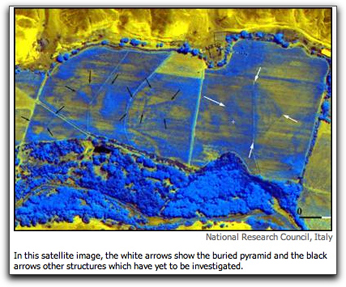
National Research Council, Italy/SatNews
Via Quickbird, Masini and colleagues collected high-resolution infrared and multispectral images.
After the researchers optimized the data with special algorithms, the result was a detailed visualization of a pyramid extending over a 97,000-square-foot (9,000-square-meter) area. .
Cahuachi is the best-known site of the Nazca civilization, which flourished in Peru between the first century B.C. and the fifth century A.D. and slid into oblivion by the time the Inca Empire rose to dominate the Andes.
[Full Story]
“Satellite discovers ancient adobe pyramid in Peru”
October 04, 2008, Malaysia Sun, Malaysia:
“A new remote sensing technology in a satellite has helped discover an ancient adobe pyramid near Peru’s Cahuachi desert.
According to a report in Discovery News, Nicola Masini and Rosa Lasaponara of Italy’s National Research Council (CNR) discovered the pyramid by analyzing images from the satellite Quickbird, which they used to penetrate the Peruvian soil.
The researchers investigated a test area along the river Nazca.
Covered by plants and grass, it was about a mile away from Cahuachi’s archaeological site, which contains the remains of what is believed to be the world’s biggest mud city.”
[Full Story]
“Archeologists in Peru unearth human sacrifices”
September 18, 2008, Reuters India, India:
“Three teams of archeologists in Peru have in the past week uncovered remains of human sacrifices carried out by ancient civilizations, including the skeleton of a pregnant woman.
At the Cahuachi site in southern Peru, Giuseppe Orefici, director of the Italian center for pre-Colombian research, found two bodies along with textiles and ceramics.
Cahuachi was part of the Nazca civilization, which flourished in Peru between AD 300 and 800 whose members carved massive lines depicting birds and animals in the Peruvian desert that are best viewed from the air.
‘A human sacrifice is very important’, said Giuseppe Orefici, an archeologist who has spent decades excavating Cahuachi. ‘Human sacrifices added to the value of the offering’, he said while standing next to a central pyramid that rises from the flat desert.”
[Full Story]
“Artifacts and textiles found at Cahuachi ceremonial center”
September 04, 2008, Andina, Peru:
“A team of archaeologists led by Giuseppe Orefici presented a report of this year?s archeological excavation works carried out in Cahuachi, a major ceremonial center of the Nasca civilization in Peru, occupied from between AD 1-500.
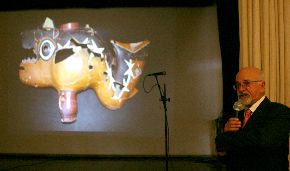
Andina/Jorge Paz
Artifacts and remains found at Cahuachi include engraved gourds with nature-related and abstract designs, pre-Inca textiles and ceramics as well as the remains of a sacrificed child.
The Ceremonial city of Cahuachi is located about 28 kilometres away from the modern city of Nazca, at the lower section of the Nazca Valley, virtually in the middle of the desert.
Since 1982, Italian archaeologist Giuseppe Orefeci has begun tireless work uncovering the ancient city of the Nazca people.”
[Full Story]
“Archaeologists explore Peruvian mystery”
May 22, 2008, PhysOrg, USA:
“Indiana Jones may be flying over the Nazca Lines in Peru in his latest Hollywood adventure, but two British archaeologists have been investigating the enigmatic desert drawings for several years.
Dr Nick Saunders from Bristol University and Professor Clive Ruggles from the University of Leicester are locating and measuring the lines with high-precision GPS, photographing the distribution of 1,500-year old pottery, and painstakingly working out the chronological sequence of overlying lines and designs.
Funded by the Anglo-Peruvian Cultural Association in Lima, their research hopes to unlock the purpose of the dazzling but confusing array of desert drawings.
Bizarre explanations, such as alien visitations, ancient landing strips, and astronomical calendars are being replaced by serious archaeological and anthropological ideas.”
[Full Story]
“Archaeologist ‘strikes gold’ with finds of ancient
Nasca iron ore mine in Peru”
January 29, 2008, Purdue University, USA:
“A Purdue University archaeologist discovered an intact ancient iron ore mine in South America that shows how civilizations before the Inca Empire were mining this valuable ore.
|

Purdue University, USA
|
|
Kevin J. Vaughn, a Purdue assistant professor of anthropology, holds a pottery fragment he discovered at an excavation site in Nasca, Peru. The piece of pottery is from about the 5th century A.D., which is the same time period as other artifacts he uncovered at Mina Primavera.
|
‘Archaeologists know people in the Old and New worlds have mined minerals for thousands and thousands of years’, said Kevin J. Vaughn, an assistant professor of anthropology who studies the Nasca civilization, which existed from A.D. 1 to A.D. 750. ‘Iron mining in the Old World, specifically in Africa, goes back 40,000 years. And we know the ancient people in Mexico, Central America and North America were mining for various materials. There isn’t much evidence for these types of mines.’
‘What we found is the only hematite mine, a type of iron also known as ochre, recorded in South America prior to the Spanish conquest. This discovery demonstrates that iron ores were important to ancient Andean civilizations.’
In 2004 and 2005, Vaughn and his team excavated Mina Primavera, which is located in the Ingenio Valley of the Andes Mountains in southern Peru. The research team performed field checks and collected some samples in 2006 and 2007. The findings of the excavation are published in December’s Journal of the Minerals, Metals & Materials Society.
The researchers determined that the mine is a human-made cave that was first created around 2,000 years ago. An estimated 3,710 metric tons was extracted from the mine during more than 1,400 years of use. The mine, which is nearly 700 cubic meters, is in a cliffside facing a modern ochre mine.”
[Full Story]
“We know who drew these giant shapes in
Peru’s desert – but why?”
December 10, 2007, The Miami Herald, USA:
“Everyone here, it seems, has a theory about the Nasca Lines. The mysterious markings on the desert floor are a massive astronomical calendar. That’s a popular one.
Or maybe they point to hidden reserves of water, the source of life in the desert.
Then there’s my favorite: UFO landing site. Forty years ago, Danish writer Erich Von Daniken popularized that theory with his best-selling book Chariots of the Gods?
Now, strapped into a four-passenger Cessna circling over a figure called the astronaut, I’m not sure what to think. One of its hands points to the sky, another to the ground. His owlish eyes stare into mine. Look at me, the 1,500-year-old seems to say. Can you solve my mystery?
Here’s what’s known: For hundreds of years, the Nasca people created lines on the ground. Some form familiar figures: a spider, hummingbird and dog. Others – a whale, monkey and parrot – don’t belong in the desert at all.
The only way to see the Nasca Lines is from the air. That makes them even more mysterious. How did pre-Inca people make these images without being able to fly? And what was the point of forming lines if they couldn’t appreciate their glory? The lines weren’t even discovered until 1929, when a pilot flew over the area and was astonished to see eyes looking up at him.
Thanks to the ancients, the town of Nasca now has a veritable air force: More than a dozen companies fly planes over the lines. The tours are an industry, as indicated by the handwritten sign taped to my plane’s instrument console. ‘Tips are welcome’, it says in six languages.
Not bad for a dusty desert town of about 20,000, a six-hour bus ride south of Lima. The modern city of Nasca, a place that gets less than an inch of rain a year, owes its prosperity to the mysterious markings. Statues inspired by the desert figures decorate the town plaza. Sketches of the lines are everywhere else. Elongated hummingbirds mark store signs, while a lizard graces City Hall. On sidewalks, brass inlays of a monkey and spider reflect the sun.
But the lines might have been forgotten without Maria Reiche. She came to Peru from Germany in the 1930s as a tutor and eventually dedicated her life to documenting the creations. For years, she surveyed the area, measuring the markings and pondering their meaning.”
[Full Story]
“Nostradamus Prophecies Linked to the Nazca Lines”
June 12, 2007, PR-GB, Bulgaria:
“Michel Nostradamus, history’s most famous prophet, died in southern France in the late sixteenth century. The lines of Nazca are one of archaeology’s greatest mysteries and were created nearly a thousand years earlier on a faraway continent.
A direct connection between the two is surely impossible, no? ‘To the contrary, it’s highly possible’, says Morten St. George, author of a Nostradamus decoding book called Incantation of the Law Against Inept Critics: A Guide to Cryptic Thinking.
St. George’s sensational decoding breakthrough was discovering that more than a half dozen of the Nostradamus prophecies cover, with extreme accuracy and detail, major historical events of an Andean people known as the Incas. ‘The prophecies in question stand among the easiest to decode. No one ever did so because no one ever imagined that Nostradamus could be prophesying about such things.’
Moreover, in a couple of those prophecies, the author displays signs of emotion over the future dire plight of the Andean people, implying that there was direct contact if not a bond of friendship.
A reaffirmation comes in the first line of prophecy VI-2, which reads ‘In the year 580 more or less.’ Interpreters normally assume poetic license to add a thousand years. ‘Not necessary,’ says St. George.
‘580 are correct as it stands. Prophecy VIII-76, internally claiming to signal the time of authorship, recounts in detail known historical events occurring in England around 580 A.D.’“.
Meanwhile, it seems the people of Nazca used wooden stakes to mark out their lines, and archaeologists, using radiocarbon dating techniques, have determined that they began their grandiose project in the Peruvian desert around 580 A.D..”
[Full Story]
“Priests may have designed Nazca lines, expert says”
September 24, 2006, Arizona Star/Reuters, USA:
“High priests at an ancient religious compound in southern Peru may have designed the mysterious Nazca lines, a set of huge geometric patterns, animal figures and long lines etched in the desert, the area’s top archaeologist said.
Researchers say the Cahua-chi compound, built in 400 B.C., is just across the Nazca Valley from the lines, one of Peru’s most popular tourist attractions and a U.N. World Heritage site.
The work is part of the Stonehenge Riverside Project, designed to explore the archaeological evidence from the landscape around Stonehenge, Woodhenge and Durrington Walls, and to examine this wide complex of monuments and human activities.
‘It is logical to think that the Nazca people’s religious beliefs originated in this ceremonial site and got expressed on the wide-open plain’, Italian archaeologist Giuseppe Orefici, who leads research at Cahuachi, said last week.
Geographical proximity is not the only evidence of links between the two ancient sites ? the same religious icons appear at the lines and on ceramics and crafts excavated at the Cahuachi compound.”
[Full Story]
“Mystery Triangles Break Nazca Code”
August 27, 2004, PR Web, USA:
“An amatuer photographer in San Diego has the local press convinced he’s solved the riddle of who made the famous lines on the desert floor at Nazca, Peru. Ten UFOs he accidentally captured in a single photograph apparently contained the rosetta stone to finally solve this ancient mystery and his popular website backs him up with evidence the Los Angeles Times labeled ‘Unsettling’.
It was just another hike thru the woods for three friends in San Diego on that glorious July day back in 1990. Only after the photos from the trip were developed did the hikers discover they were not alone.
In the distant background of one of those daylight scenic photos, a formation of nine objects were accidentally captured hovering over a nearby hillside.
‘These extraordinary photos are most pursuasive evidence of the existence of UFOs’ an expert would claim months later in a popular magazine.
On the trail that day however, nothing was out of the ordinary as the three adventurers set out to explore for the first time a beautiful loop trail at Inaja Memorial park in Santa Ysabel, California just east of San Diego.”
[Full Story]
[The phenomena of strange lights in the sky near to ancient sites is something that has been reported from almost every corner of the world. Until these phenomena are fully explained they do indeed remain adequately described as Unidentified Flying Objects.
But it is pure idiocy to attempt to identify them in the context of some sort of extraterrestrial lifeforms visiting our planet. Ancient peoples all over the globe were capable of performing feats of engineering that we are uanable to equal, or copy, today despite our suppposedly superior technology.
Regrettably many people are unable or unwilling to appreciate this simple fact despite the ample evidence to be found all around us – Ed.]
“Peruvian mystery in danger”
April 20, 2004, The Washington Times/AP, USA:
“Standing inside the maze of mysterious lines and figures that put this arid region on the tourist map, state archaeologist Alberto Urbano surveyed a football field-size spread of ankle-deep trash.
‘Farther down this road there are illegal gold mines, too’, he said, noting that the path is the side of a gigantic trapezoid. ‘See how straight it is.’
But it is not only trash and small-time gold diggers that threaten Peru’s fragile Nazca Lines. Grave robbers, tractor-trailers and tourists have left their mark on the vast designs carved more than a millennium ago along a 35-mile stretch of desert.
In many ways, the damage reflects Peru’s inability to protect its myriad of pre-Columbian archaeological gems.
Mr. Urbano blew the whistle on the municipality of Nazca in October for briefly dumping trash inside the 175-square-mile protected zone that has been a United Nations World Heritage site since 1994.”
[Full Story]
“Ancient Desert Markings Imaged From Orbit”
April 19, 2004, The Washington Times/AP, USA:
Visible from ESA’s Proba spacecraft 600 kilometres away in space are the largest of the many Nasca Lines; ancient desert markings now at risk from human encroachment as well as flood events feared to be increasing in frequency.
|
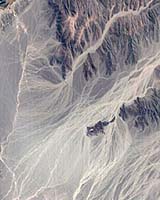
SpaceDaily
|
|
Designated a World Heritage Site in 1994, the Lines are a mixture of animal figures and long straight lines etched across an area of about 70 km by 30 km on the Nasca plain, between the Andes and Pacific Coast at the southern end of Peru.
The oldest lines date from around 400 BC and went on being created for perhaps a thousand years.
|
They were made simply enough, by moving dark surface stones to expose pale sand beneath. However their intended purpose remains a mystery.
It has variously been proposed they were created as pathways for religious processions and ceremonies, an astronomical observatory or a guide to underground water resources.”
[Full Story]
“Over 1000 new ‘geoglyphs’ discovered on Peruvian
Nasca desert”
October 08, 2002, National Geographic News, USA:
“Human and animal likenesses, a knife, and a sundial are among the “geoglyphs”, or giant figures etched into the earth and discernible from the sky, most recently discovered in the Peruvian desert.
Peruvian archaeologist Johny Islas and German colleague Markus Reindel have identified new etchings made by the ancient Nasca people in the desert valleys of Palpa, about 460 kilometers (290 miles) south of Lima.
After five years of work, the scientists were able to identify more than 1,000 new geoglyphs … “
[Full Story]
“Nazca Lines, Peru – latest satellite images”
January 15, 2001, Earth Observatory, Earth Orbit:
“It takes a view from above to appreciate the giant designs the ancient Nazca people carved into the Peruvian desert.
|
click image for higher resolution
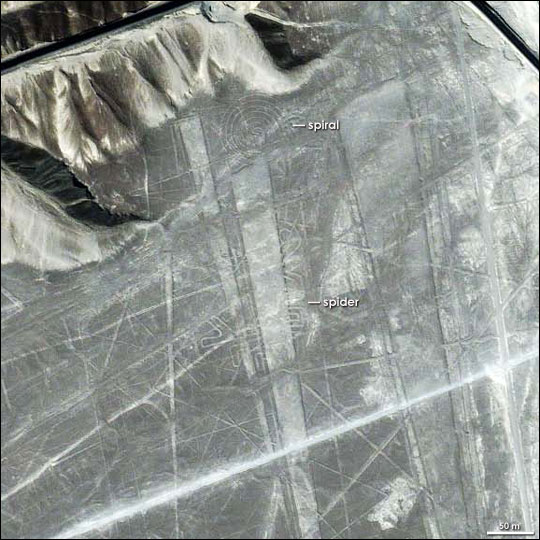
Copyright © 2001 Earth Observatory
|
|
This view from the Ikonos satellite reveals a giant spiral, a spider, and perfectly straight lines that stretch for kilometers across the desert.
The Nazca created these geoglyphs between 200 BCE and AD 600 by clearing away the dark red top soil and stone, leaving the pale underlying soil exposed.
Since the plain where the lines are carved receives little rain or wind, the lines are still visible today. This image, taken on January 15, 2001, shows two glyphs and several lines.
|
Near the top of the image, a spiral is nestled at the foot of the mountains. Below it is a spider, with its pincers facing the left edge of the image.
Since the lines are difficult to see from the ground, the artists may never have seen their work from this perspective. So why did the Nazca go to the trouble of scribbling over the desert?”
[Full Story]
“El Niño vs. The Giant Monkey”
February 09, 1998, Science Now, USA:
“The mysterious giant birds and other animals etched into the desert near Nazca, Peru, may be in peril.
Torrential rains in the Andes this week have sent rivers of mud sweeping across the plains.
So far the flooding has only smudged a few lines on the 500-square-kilometer desert canvas, but locals worry that some of the ancient images may be lost if preventative steps aren’t taken soon.
Over a millennium ago, people of the Nazca region carved kilometer-long lines and images into the yellow-white clay of a desert plateau on Peru’s south coast.
More recently, another line has been added–the Pan-American highway, which cuts across several of the designs.
The roadwork and El Niño weather patterns are conspiring to destroy the famed artwork, says José Lancho, a local historian of Nazca.”
[Read The Full Story]
|

